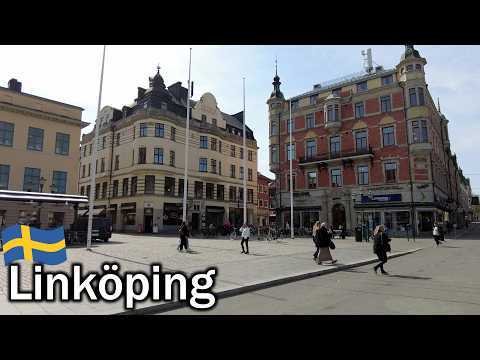Sweden, walking tour of the beautiful city Linköping.

Welcome! Today we're walking in the city Linköping. We start outside the Linköpings Castle. Originally there was a bishops mansion located here, built in 1153 for the bishop Gisle. Parts of that old building still remains as a part of the western section of the castle.
The western section is the central part, the north section is on the right side and the south section on the left. The last Roman Catholic bishop to live here was Hans Brask, who fled to Danzig during the reformation in 1527. After that it was taken over by the crown and converted to a royal castle. It was then slowly expanded and converted to a renaissance castle in several steps over the years.
By the year 1604, all three sections had reached 3 floors and the castle was completely in the renaissance style. In January 1700 a huge city fire burned to most of central Linköping, but both the castle and nearby cathedral survived the fires. After that the castle was mostly abandoned, but the eastern part of the north and south sections was turned into a prison.
In 1795, the castle began to be transformed into an official building for the governors of Linköping. Here we can see the Linköping Cathedral, as you can see, the tower is being renovated and is currently covered. We will see it appear now and then during todays walk and I have a separate video of the inside of the church that I will post later. I will talk about the history of the church in that video so for now, let's return to the history of the castle. When converting the castle to a building for the city governors, a lot of the renaissance decorations was removed.
in the late 19th century, there was a desire to recreate the building as a historical renaissance castle. But in 1930 the newly added renaissance decorations was once again removed. During a renovation of the facade in the 1990s all the old surface material was replaced with a classic medieval lime mortar. This building is "Stadshuset" (the city hall) It was originally built in 1864 as a school building, design by Johan Fredrik Åbom. in 1915 the school moved out and the building was converted to the city hall with designs by the architect Axel Brunskog. in 1921 it was inaugurated as a city hall.
The stone building on our right side is "Stenhusgården" which was built around the 14th or 15th century. The road we're currently walking on is part of the road network designed in the 17th century. The building's slightly angled position compared to the road shows us how it used to align with the previous roads placement. The sign we just passed mentioned this building "Krogen Amerika" (the America Tavern).
It was originally built in 1704 but got it's name from the tavern that used to exist in it during the 19th century. Here's a sign describing "Stenhusgården". Other than what I've already talked about, it also mentioned that the high roof was added after the fire of 1700. People have been living in this area for a long time, over 10000 years old remains of a settlement has been found.
The earliest written mention of Linköping dates back to 1104, at that time it was written as "Liunga kauping". That old document was from when Lund became the archbishopric of the Nordic countries and all the Nordic dioceses, including Linköping, were listed. The second known written mention of Linköping is from 1153, when the first large church meeting was held in Sweden.
The meeting was hosted by Bishop Gisle and King Sverker the Elder and lead by Nicholas Breakspear (who later became Pope Adrian IV). The hopes of Gisle and King Sverker was that Linköping would become the archbishopric of Sweden, but no such decisions was made. Instead Uppsala became the archbishopric of Sweden in 1164. Now we're about to arrive at "Stora torget" (The main square). This was the location of the "Linköping blodbad" (Linköping bloodbath) that we will talk about a bit later.
It was also here that the large fire of 1700 started. There are several 100+ years old buildings to be found around this square. This statue was made in 1924-1927 by Carl Milles and it depicts Folke Filbyter, the supposed progenitor of the house of Bjälbo.
Though later research questions whether Folke Filbyter was actual a real person or not. He is also the protagonist of the novel called "Folke Filbyter" from 1904, written by Verner von Heidenstam. The building we see here is the old "rådhuset" (town hall), built 1799, the architect is unknown. But back to the history of Linköping, I mentioned the Linköping bloodbath a while ago.
The events leading up to that started at the end of the 16th century, when the current king was Sigismund III Vasa. Sigismund was the son of King Johan III and the Polish princess Katarina Jagellonica. Sigismund first inherited the throne from his mothers side, becoming the king of the Polish-Lithuanian union in 1587. Then, when his father died in 1592, he also became the King of Sweden.
Sigismund, like his mother, was a devout follower of the Catholic faith. As mentioned previously, Gustav Vasa (Sigismunds grandfather) had started the reformation in 1527. The reformation ment converting the country from Catholicism to protestantism, moving the power over the church from the Pope to the crown.
With Sigismund being a devout Catholic and him following advisors assigned by the Pope, it seemed the country might move towards Catholicism again. This was opposed by Duke Karl (or Charles), Sigismunds uncle, and Gustav Vasas third son. Things escalated into what is now known as the War against Sigismund (1598-1599). One of the deciding battles was fought on 25 September 1598 at Stångebro, just outside Linköping. After Duke Karl had taken control, several supporters of Sigismund was charged with treason and 5 of them was executed.
Those executions are what we now call the Linköping bloodbath. There has been some debate about the location of the executions, but the most recognized location is the main square. The War against Sigismund continued into several wars between Sweden and Poland (1600-1611, 1617-1618, 1621-1625 & 1626-1629). In 1604 Duke Karl was crowned King of Sweden as Karl IX (or Charles IX). By the way, the square we walked past a moment ago seems to be called "Trädgårdstorget" (the garden square). But other than seeing the name on google maps, I haven't found much information about it.
I looked at a map from 1691 and it seems like there was something in roughly that area. But I have no idea if it was that square or not, the maps from that era doesn't really have that much precision. So it might have been something completely different back then. This is "Sankt Lars kyrka" (Saint Lars Church), dedicated to Saint Laurentius. It was first built in the 12th century, but as usual, it's seen a lot of expansions and renovations over the years. Findings in the area shows that the grounds around the church has been a Christian burial ground since the 11th century.
I did say that I'll talk more about the cathedral in my next video, but it's worth mentioning that it is built around the same time as this church. So back in the 12th century Linköping was already big enough to have had two churches. And before this church was built there was a stave church in this location, built around the 11th century. But with this, I've run out of things to talk about, so I'll be quiet for a short while. The tree sculpture here was recently made by the chainsaw sculptor Bert Davidsson.
This sign tells us that this is "Gamla Riksbankshuset" (the old Central Bank Building), built in 1903 by Sweden's central bank. It was designed by F O Lindström and the bank was operational here until 1988. Reading online, I saw one page claiming that the yellow building on our right was the first "Sparbankshus" (savings bank house) in Sweden. That same page claims that it was built in 1860.
Though it doesn't quite seem to match with what I find in other sources. Supposedly the first savings bank was founded in 1820 and by 1870 there was 375 savnings banks in Sweden. Doesn't it seem strange if the first savings bank building wasn't built until 1860? Maybe it was the first savings bank building built specifically to house the bank? This building was built 1858 and designed by C E Ferngren. It was used by "Ljungstedtska skolan" (the Ljungstedt school).
The school got its name from Anders Ljungstedt who donated money to have it started. The first Ljungstedt school started in 1824 with a focus on giving poor boys a work related education. Now we can once again see the cathedral in the distance.
Seeing it from a distance like this almost gives a better view of it's size than seeing it up close. Here we have the Linköping Theatre, built in 1902-1903 and designed by Axel Anderberg. It was one of the earliest buildings in Linköping to have electricity. During the inauguration on December 18, 1903, visitors were greeted by hundreds of electric lights. This sign tells us that at the time of construction the theater this location was on the outskirts of the city.
We're currently walking through "Raoul Wallenbergs plats" (Raoul Wallenberg's place), a park dedicated to Raoul Wallenberg. Raoul Wallenberg was a Swedish businessman and diplomat who served as Sweden's special envoy in Budapest from July-December 1944. At that time, he saved thousands of Jews from the then Germany occupied Hungary during the later part of World War II.
He has at times been described as the Swedish Schindler. In January 1945, after the Soviet Union captured Budapest, he was captured on suspicion of espionage by Soviet troops. Very little is known about what happened to him after that.
In 1957, Soviet authorities reported he had died from a heart attack on 17 July 1947 while imprisoned. This is a memorial for Raoul Wallenberg, it was placed here on August 4, 2002, which would have been his 90th birthday. The artist is Gerö Gabor Bottos.
This is the Östergötland museum, Östergötland is the county that Linköping is located in. Here is "Linköping Konsert & Kongress" (Linköping Concert and congress). This completely covered building is now called "Dansens hus" (the house of the dance) and was built 1880-1882. It was originally built as a gymnasium for the cathedral school. The architects were Rudolf Ström and Axel Fredrik Nyström Now we're arriving at "Hunnebergsgårdarna", these old wooden buildings are from the 18th and 19th century.
The sign on the side tells us that these days, they have "Konst & Hantverk" (arts & crafts) here. I have to admit, I have no idea why I did not slow down and turn my camera towards the left side in here. I will have to blame it on the fact that it was hot and I was tired after taking to many walks in to short time. Here I noticed that the gate ahead was closed so I decided to take another route just in case it was locked.
Now we've reached the end of the walk, I hope You've enjoyed it! Thank You for watching!
2024-08-04 20:31


